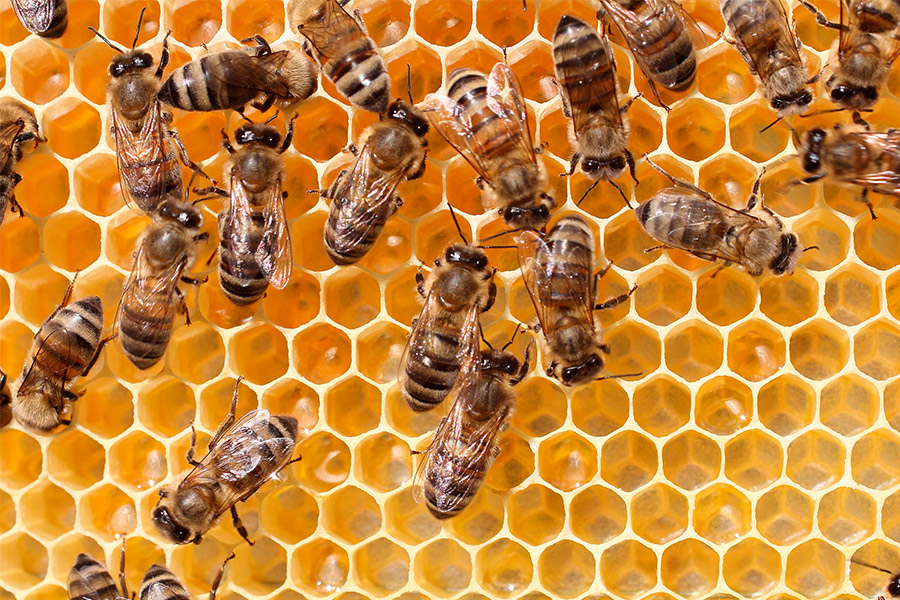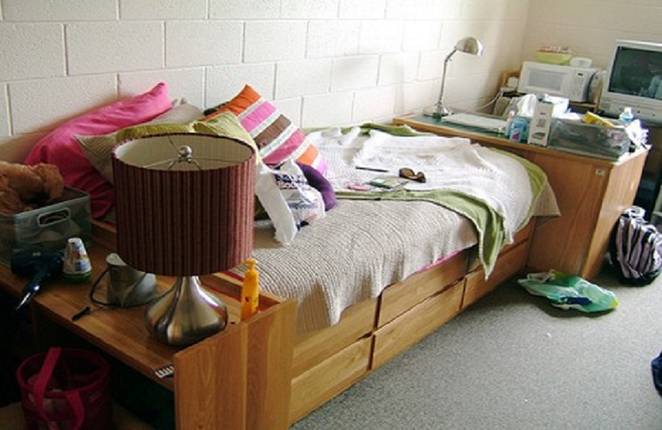August 31, 2015 by Penny Swift
People have been keeping bees for centuries, both for beeswax and for honey, but there is still an incredible mystique about bee keeping. This is probably because bees generally move is swarms and if they attack they can kill any sized human. Coupled with this, many people are allergic to bee stings, and even one bee can cause a reaction that can be life threatening.
But over time we have learnt a great deal about bees and bee keeping, and with the equipment available today, just about anybody can set up beehives and keep bees for their honey and/or wax – safely and successfully. Better still, keeping a colony of honeybees can be incredibly rewarding.
Of course if you live in a rural area, it will be a lot easier for you to plan for beehives, however, an increasing number of people are keeping bees in suburban gardens and even in rooftop gardens in towns and cities. If you are in an urban area you won’t be able to keep as many hives as you can in country areas, and you will also need to be sure that you aren’t breaking local authority codes or bylaws. Once you establish that it’s legal and above-board, you can start planning, and begin to anticipate the fruits of your labour – delicious organic honey.
So what do you need to set up and keep bees? And how much do you need to know to be able to extract your own honey and bottle it? This article aims to introduce you to the fundamental principles of keeping honeybees, including the provision of hives and acquisition of bees. It will give you some insight into caring for your bees and dealing with potential problems, including disease, as well as the principles of extracting honey, how to bottle it, and what you need to do to harvest the wax that is part and parcel of all beehives.
Where to Keep Beehives
You really can keep honeybees just about anywhere since bees will travel long distances to forage for whatever they need. But you do need to ensure the ground on which the hives are kept is well drained, and that there is a water source nearby that they can access. Generally minimal wind and dappled sunlight (rather than full sun) are best, and the hive should have good ventilation.
Equipment to Keep Honeybees
Equipment required to keep honeybees includes beehives, protective clothing, a smoker to help the beekeeper distract the bees and get access to the hive more easily, as well as a few other tools.
Beehives
Contemporary beekeepers owe a lot to the American inventor Lorenzo Langstroth, who designed an easy beehive system about 160 years ago. Essentially all it was – and still is – is a movable structure that comprises a set of crates (or boxes) into which frames are placed, and a lid. Completely practical and ground-breaking at the time, the Langstroth hive made it possible to keep track of what was happening inside the hive, and in this way ensure that the bees all stayed healthy. It also made it possible to exclude the queen bee from the area where the honey was produced, and enabled the bees to build honeycomb into the frames. Additionally, it made it possible to remove honey from the hive without disturbing the bees.
Even though the original Langstroth beehive design was a lot simpler than the so-called Langstroth hives available today, the concept remains the same, and it is undoubtedly the most popular choice of hive for those who are serious about producing honey, either for their own consumption or commercially. These are relatively easy to source online and at regular beekeeping supply shops.
In simple terms, these hives comprise a series of boxes called supers that are either deep or a medium size – and where the queen bee will lay her eggs, and the other busy bees will look after the larvae. Then there are honey supers that are used by the bees for their honey stores, to keep the young bees fed. There are usually ten frames in the honey super box, all of which are reserved for the bees. Medium or shallow boxes are normally used above these, also with frames – and this is where you will harvest your honey.
The queen lives in the lowest box, and once the hive is established, you will only need to access this box now and then to check that the queen is still healthy. Generally the queen bee will live for about four years, after which she will need to be replaced by a new queen. A “queen excluder” should be positioned between the honey supers and the brood box to stop the queen from laying her eggs in the honey.
Langstroth hives are generally made of wood, and their frames are relatively easy to assemble. All you do is tack the four lengths of wood for each frame together, and then insert a wax sheet, available from beekeeping suppliers. Frames are generally reinforced with wire to help support the huge volumes of honey they hold.
In addition to these proven, traditional hives, many DIY beekeepers make their own top-bar hives, often referred to as backyard hives. These are a single size, and they are often built above the ground, with viewing windows so that you can check on the bees and the honey. While considered sustainable and less invasive than most other hives, the disadvantage of top-bar beehives is that you need to replace the frames every year – and you might also need to replace the bee colony. Also, you cannot extract the honey using the traditional centrifugal method.
There are numerous plastic and polystyrene beehives on the market now, though you do need to be careful about design and quality. While these may be cheaper, bees are more likely to accept a wooden hive than a plastic one.
There are beekeeping associations in many areas, and they might know of second hand hives on the market. In any case, if you have never kept bees before, it’s a really good idea to contact your local association (if there is one) to get advice, and to know who you can contact nearby if you have problems with your bees or hives in the future.
The number of hives you keep will depend on the space you have, and the quantity of honey you want to produce.
Protective Clothing
Traditional safety clothing worn by beekeepers includes heavy-duty jumpsuits usually made of white canvas, knee high rubber boots, thick leather gloves that reach to the elbow, and a helmet with a face veil. This tends to make beekepers a bit like aliens.
While you don’t have to buy a traditional jumpsuit, you should wear clothes that cover your body, and they should be light in colour because bees don’t like dark colours, and are more likely to get angry when you interfere with the hive. You should also get boots, gloves and suitable helmet with veil, and should take steps to ensure that no bees can get into your clothing otherwise you will surely get stung. For instance, you can use duct tape to secure clothing around your wrists and ankles; just be sure it’s sealed.
It is also wise to have medication for bee stings on hand at all times. Bee stings tend to swell and they can be very itchy and extremely painful. Many people are allergic to bee stings and bees – sometimes to honey as well. Often the reactions get worse over time, causing the throat to swell and making it difficult to breathe. At worst, if a bee stings a very allergic person, it can trigger an anaphylactic reaction that could be fatal. So take precautions, even if you are not allergic.
Smokers
Beekeepers commonly use smokers that are essentially a type of bellows used to create smoke. This causes the bees to move to the lower deep boxes, to gorge on honey and protect the queen.
However many beekeepers have found that smoker freak their bees out, and use alternative methods. For instance some commercial beekeepers use a specially constructed board with a maze built in. When they want to remove the honey-rich frames in the upper supers, they spray on a proprietary product like the herbal Fischer’s Bee-Quick, and place the board over the top of the lower supers. This causes the bees to move to the bottom of the hive, and the maze prevents them from getting back to the top quickly.
An effective DIY method is to spray sugar water on the bees, or to shake a little dry powdered sugar into the hive so they are distracted and focus on cleaning each other while you do what you need to do at the hive.
Other Tools
The other tools you will need range from items stocked by beekeeping supply shops to everyday items you may already have a home.
• A flat metal hive tool is invaluable for prying hives open, particularly if the honey has gummed up the covers. Alternatively, you can use a wide, flat screwdriver, a big knife, or a carpenter’s moulding ripper.
• A light bee brush that you can use to brush bees off the frames without harming them.
• A frame grabber for times when the boxes are full and you are unable to get your fingers between them without risking damage.
• Elastic bands to keep things together.
Bees for Your Hives
Keeping a colony of bees can be incredibly rewarding, not only because you can harvest honey and wax, but it’s also one of those amazing organic pursuits that make life worthwhile. Remember that just about every bite of food you take was made possible by a pollinator, and bees are one of the best and most important. But what sort of bees do you need?
Generally people wanting to keep bees for honey will keep honeybees, and mostly those that have been bred specifically for commercial and small-time honey production are domesticated. That doesn’t make them totally harmless, but it does mean that they will be relatively gentle and they will produce lots and lots of honey. Incredibly, you can even buy these creatures on the Internet, though there are risks particularly since they often have to be shipped long distances. The best advice is to buy bees that are already “working” in your local environment, for instance from local honeybee breeders, or at least bees that are already producing good organic honey close to where you live.
While your local environment (garden or rooftop areas) is going to determine how many hives you can have, each new swarm of honeybees will consist of anything between 4,000 and 6,000 bees plus their queen. Once the hive is fully established, numbers are likely to increase up to 10,000 to 50,000, and the bees will produce anything from 9 kg to 36 kg of honey for you to harvest.
Apart from designing a fail-safe beehive, Langstroth propounded the idea that honeybees wouldn’t ever attack if they were full of honey, and weren’t threatened by the beekeeper. Nevertheless, it is important to wear protective clothing when you transfer bees into (or out of) the hive, or even just work at the hive.
Caring For and Handling Bees
Langstroth hives have a solid base that is intended to sit on the ground. However this can cause damp problems, so people often place them either on wooden pallets or on concrete blocks. This also discourages ants and other pests from getting to the honey. It is also a good idea to position a small screen over the back opening of the hive. If you live in a rural area where honey-eating mammals are common, it’s best to install electric fencing around the hives. These include raccoons, skunks, honey badgers, bears, and even jackals.
Once your hives have been assembled, positioned, and stocked with bees, there’s not a lot that you need to do. Unless they have access to pollen and nectar nearby, you should feed them supplementary “nectar” made from sugar dissolved in warm water, usually either via a top feeder or an entrance feeder. These devices can also be used to medicate unhealthy bees.
Most other tasks are seasonal:
- Just before winter you need to “winterize” the hive to help keep the bees warm. Then just leave them alone. If you want to check on them put your ear against the hive and you’ll normally hear a pleasing buzzing sound.
• In spring you will remove the material used to winterize the hive. You should check the bees for disease – not forgetting the queen bee. Then feeding can begin again, and you can check every now and then.
• Check for disease again in summer and if the queen is not in perfect health, replace her. If the bees are starting to outgrow their supers, add a new one to the hive.
• Fall is when you should extract honey from the top supers. You should also check for disease again. Check and treat for mites just before winter, and feed one last time before you “winterize” the hive.
Bee Health and Disease
While you certainly don’t have to check on the bees every time you visit the hives, it’s good practise to keep an eye for moisture, bugs, mites, and any signs of disease.
Mites
In a previous article we talked about Colony Collapse Disorder (CCD) that is causing the demise of honeybees worldwide. One of the causes might be the varroa mite since it destroys beehives by attaching itself to the backs of the bees and spreading disease through the hive. On the positive side, these little mites are visible to the naked eye, and you can get rid of them.
There are commercial products that you can use to fight against mites, including strips that are positioned in the hive. Just make sure you use a product that is safe and natural.
You should check for mites in early fall. A reasonably easy method is to scoop out enough bees to fill a standard mason’s jar; add a few tablespoons of powdered sugar; cover with mesh; then shake the jar over a white surface or sheet of paper. If there are mites on the bees, these will drop out and they will probably be alive. If there are any mites in the hive, now is the time to treat.
Hive Beetles and Wax Moths
While a really good cold northern hemisphere winter will usually kill hive beetles and was moths, they can be a real problem in milder climates. A precaution is to sprinkle diatomaceous earth around the hives, particularly to deter beetles. If you spot moths in or around the hives, don’t be tempted to use mothballs of any sort as they will contaminate your honey. Instead, handpick them off the hive and destroy any cocoons.
Foul Broods
Bacterial diseases that can be deadly, foul broods are a real problem, because there don’t seem to be any organic ways to treat them. There are chemicals that might kill the bacteria, but chances are these are going to contaminate your honey.
At the end of the day, the best way to prevent any form of disease is to keep your bees healthy. So keep checking them regularly, and if anything appears to be wrong, take action instantly.
Extracting and Bottling Honey
One of the delights of keeping your own beehives is that you will be assured of raw, organic honey. Unlike most commercial honey products, you won’t heat it to a high temperature or strain it multiple times. Instead you will be able to preserve the valuable pollen, proteins and natural enzymes that occur naturally in honey, which is what gives it its wonderful medicinal value, and makes it a broad-spectrum healer and natural allergy combatant.
Early fall or autumn is the time to harvest honey, after the bees have spent the summer producing lots of honey for themselves (for winter) and a whole lot more for you.
Equipment to Extract Honey
To extract honey from Langstroth and similar beehives, in addition to the equipment already mentioned, you are going to need:
• A big tub with a metal screen at the bottom, and a honey gate that can be securely opened and shut.
• A bucket, also with a honey gate.
• A honey extractor or spinner.
• An uncapping knife or a large serrated bread knife.
• A mesh metal strainer.
• Enough jars to fill with honey.
These items are available from any good beekeeping supply shop, including those on the Internet.
The extraction process will normally take about three days from the time you “evacuate” the bees from the hive, to the moment you are ready to bottle your honey. This is briefly the process that you will need to follow:
- Evacuate the bees
2. Remove the honey supers
3. Reassemble the hive
4. Prepare the frames for the extraction process
5. Uncap the frames
6. Drain the honey
7. Spin the honey
8. Strain and bottle the honey
Evacuate the Bees
Evacuating your bees doesn’t necessarily mean getting them to leave the hive, it means getting them to move to the bottom super. You can use a smoker, or spray a board as described above.
Remove Honey Supers
Once the bees have been distracted, remove the honey supers that contain your honey. If there are bees on the frames, brush them off gently so they fall back into the hive. You are unlikely to be able to remove all the bees, either from the equipment or from yourself, but do the best you can.
Place the frames on a wagon or trailer, or whatever you are using to transport them, and cover them with large towels, an old tablecloth or sheet to protect them from the bees and prevent any of them from tagging along when you leave.
Reassemble the Hive
Reassemble the hive by reattaching the outer and inner covers and removing any boards you used to evacuate the bees. Then head home with your supers and “stolen” honey. First check that there aren’t any bees on the frames, and then stash the honey supers inside to prevent the bees finding them… if they do they will alert other bees in the colony and systematically work on getting the honey back to the hive.
Prepare the Frames
Allow the frames to sit overnight so that the honey warms up a little and flows more easily. Get all the equipment you need for extraction together, and find lots of helping hands.
Uncap
Place four or five frames in the tub and then start to saw the caps off the frames; these are the layers that seal the honey. Allow the wax cappings to fall to the bottom of the tub so they rest on the metal screen. Leave them there to allow all the honey to drip to the bottom of the tub.
Drain the Honey
Now you can use the honey gate at the base of the tub to drain the honey you have extracted. This is an amazingly rewarding job and you’ll find that you will get the tastiest honey ever from the hive.
Retrieve the wax cappings and wash them… they too have their use.
Spin the Honey
This is the step that enables you to extract much more honey than just allowing it to drip through the screen. Having sliced off the cappings on both sides of the frame, place the frame on the extractor and start spinning. Some extractors allow you to spin out two to four frames at a time, making the process considerably quicker.
Some extractors are easier to work with than others, but generally you will need at least one other person to help extract the honey. Once spinning is complete, allow the honey to drip to the bottom of the extractor before starting on the next batch of frames.
Strain and Bottle The Honey
Strain the honey from the extractor into the bucket without touching! Put a lid on the bucket and let it sit overnight to get rid of air bubbles.
Then you need to decant it into suitable containers. These must be clean and sterilized before you fill them. Also be sure to label them correctly.
If you want creamed honey, all you do is whip it before decanting into jars, though often raw, organic honey will crystallize and thicken on its own, particularly in cooler weather.
Using Comb Honey
The alternative to spinning honey is to extract the honey together with the comb. Comb honey has a more distinctive flavour than other honey and you are more likely to taste the flavour of the plants the pollen comes from – for instance berries, blossom, herbs or flowers.
All you do is to cut the comb with a heated knife, place it in a jar and allow it to drip slowly into the jar.
The only downside to using comb honey is that the bees will need to start producing the wax foundation all over again – from the wax sheets you provide. If you spin honey, you can reuse the wax frames many times over.
Collecting Beeswax
While honey is likely to be the primary purpose most people keep bees, people have been using beeswax for centuries. In relatively recent times, during the 19th century Victorian era, people used beeswax for candles, to seal paper, preserve flowers, coat candy, and even for waterproofing. Women even used beeswax to improve the texture of their skin.
Wax comes from the wax cappings on your frames, and even though it will take a while to collect enough to use, it’s worthwhile keeping it until there is enough to use.





